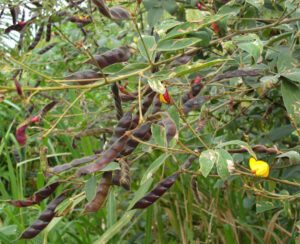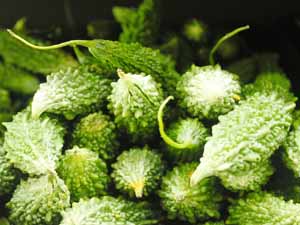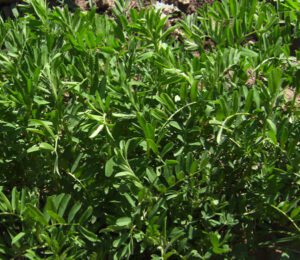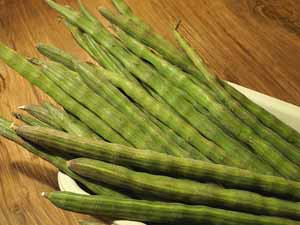Sponge gourd farming is a traditional practice. But it was not produced commercially in the ancient times. Rather people used to plant a few sponge gourd plants for family consumption.
The sponge gourd plant is a vine-like plant is a part of the cucumber family. The vines can attain the height of 30 feet or even more. It is known by many different names in different parts of the world. But most commonly it is known as ‘Luffa‘.
Sponge gourd is famous for it’s inner sponge. The fruits are cylindrical in shape and outer skin is smooth green. And the fruit contains white inner flesh which is fibrous and have pretty similar flavor to bitter melon.
Depending on the variety, the fruits can attain 1-2 feet height. Rather than using as food, sponge gourd is very popular for it’s inner sponge. Fully ripened sponge gourd contains high fiber content which is used as cleansing agent and for making table mats, shoe-soles etc.
When used in food, it is harvested at younger stage. It is a good source of vitamin A and vitamin C. Consumption of sponge gourd helps to cure jaundice, diabetes, to purify blood, and also used to cure skin diseases.
However, here we are going to share more information about commercial sponge gourd farming business. Sponge gourd has good market value and demand, and both are increasing gradually. So, commercial sponge gourd production can be a very good business for making good profits.
Importance of Sponge Gourd Farming Business
Before reading more about commercial sponge gourd farming, you should know more about the importance of this crop. Here we are trying to list the most important importance of sponge gourd farming business.
- Sponge gourd is a nutritious vegetable. It is rich in essential vitamins, minerals and dietary fiber. It is a good source of vitamin A and vitamin C. It contains very low amount of calorie and consumption of sponge gourd helps to promote good health and wellness.
- Consumption of sponge gourd helps to purify blood, cure jaundice, diabetes, and also used to cure skin diseases.
- Inner sponge of the ripen fruits is sued as cleansing agent and used for making table mats, shoe-soles etc.
- Commercial sponge gourd production can be a great income source for the new and existing farmers. Production cost is very low and it has very good market demand as well as good price. So, commercial production will definitely be a very profitable business.
- Sponge gourd plants are very strong and hardy, and they can grow in various climatic conditions. They can tolerate different weather conditions and different soil types.
- Market demand and value of sponge gourd is very good and both are increasing gradually.
- Like bottle gourd, sponge gourd farming also can help to improve soil health. Because, these plants have extensive root system and it helps in soil aeration.
- Commercial production can be a great income and employment source for the educated but unemployed young people.
How to Start Sponge Gourd Farming Business?
Starting commercial sponge gourd farming is similar to many other crop farming business. Production of sponge gourd is relatively easy and simple. You can easily start this production even if you are a beginner.
Sponge gourd plants are very strong and hardy, and they generally grow well almost everywhere. And caring these plants is very easy. We recommend completing a short training before starting commercial production.

Try to visit as many farms as you can before starting your operation. Because practical knowledge is very important for every business. However, here we are trying to describe more information about starting and operating a successful sponge gourd farming business from planting, caring to harvesting and marketing.
Step 1: Site Selection
Selecting a good site is very important for profitable sponge gourd farming. You can use your existing land for your business if there is enough sunlight available. Ensuring good drainage system is also a must.
Sponge gourd plants are very hardy and they can thrive and grow well in a wide range of soil types. But sandy loam type soil enriched with good amount of organic matter is considered best for these plants. The pH value of the soil ranges from 6.5 to 7.0 or neutral to slightly alkaline soil is good for ideal plant growth.
Step 2: Land Preparation
Preparing the land perfectly is also another important part of successful sponge gourd farming business. Adequate ploughings are required to bring the soil to the fine tilth and to make the field weed free.
Add as much organic fertilizers as you can while preparing the land. Try to add 8-10 tons of Farm Yard Manure per acre of land during ploughing. Doing this will help to get better quality sponge gourd production.
Step 3: Consider The Climate Requirement
Sponge gourd grow well in warmer climatic conditions. These plants grow well and produce maximum within temperature ranging between 25°C and 28°C. Sponge gourd plants can be grown twice a year. The ideal time for sowing the seeds is in the month of mid-February to March, and second time in the month of mid-May to July.
Step 4: Choose the Right Variety
There are many different types or varieties of sponge gourd available to choose from. Try to consult with some existing farmers in your area for having better recommendations. Try to determine your local market demand and price while choosing the right sponge gourd variety.
Step 5: Purchase Seeds
After selecting the variety, purchase good quality seeds from authentic suppliers. You can purchase good quality seeds from your local suppliers or order online.
Step 6: Planting
Sow two seeds per pit, and keep 75 to 90 cm spacing between plants to plants and 2-3 meter between rows. Sow the seeds at the depth of 2.5-3 cm.
In case of planting in pot, take a pot of your choice and fill it with a proper amount of potting layers. Then plant the seeds in the pot around 2 cm deep into the soil.
After planting, the seeds would germinate within 6 to 8 days. Cotyledons would emerge in the second week of germination, and the first leaf would come above the cotyledons at the end of second week. And after second week, seedlings would start growing into small plants. Keep only one healthy seedling at one pot and remove the weak ones.
Step 7: Caring
The sponge gourd plants are very strong and hardy plants and they generally require less caring and other management. Although, taking good care of the plants is important to ensure good production. Follow these essential caring steps for better growth and production.
- After planting the seeds, keep the pot in a sunny and airy location under open sunlight.
- Ensure providing of adequate water during summer. If possible try to provide water daily during summer season.
- Add as much organic fertilizers as you can while preparing the soil. And then try to add some additional organic fertilizer and compost occasionally.
- Provide the support system for the plants. Doing this will increase flowers and fruit production.
- If required, use a fence or some other strong thing around the plant for additional support.
- Inspect and analyze your plant growth and health regularly.
- Spray or apply medicine as soon as possible if you notice any symptoms of any fungal infection or disease.
Step 8: Feeding/Fertilizing
Along with providing the plants with enough organic fertilizers, it will be better if you provide some chemical fertilizers also. Although, application of chemical fertilizers is not recommended for organic or small scale farming. It is recommended only for commercial production.
If you decide to apply chemical fertilizers, then apply Urea 90 kg, Single super phosphate 125 kg, and Muriate of potash 35 kg per acre during the time of land preparation. And do another same application during the early stage of vine production (one month after sowing).
Step 9: Watering
Adequate watering is a must for good plant growth and maximum production. During the summer days, try to water regularly with an interval of at least 7 days. No irrigation required during the rainy season. First watering is a mandatory which is immediately after sowing the seed.
Step 10: Mulching
Providing mulch will help to hold enough moisture into the soil, and at the same time it will help to prevent weed growth. Try to use organic materials as mulch.
Step 11: Weeding
Regular weeding is a must for controlling the weeds. You can control weeds by using weedicides or by using mulch.
Step 12: Pests & Diseases
Like many other commercial crops, the sponge gourd plants are also susceptible to some pests and diseases. Common disease of the sponge gourd plant is Powdery mildew. Application of M-45@2gm in 1ltr of water will help to cure powdery mildew.
Common pests of these plants are Aphid, Beetles and Thrips. These pests damage the flower, leaves, stems and suck the sap from the leaves. Use appropriate insecticidal spray to control all these pests. Consult with an expert in your area for better recommendation.
Step 13: Harvesting
Exact harvesting time depends on your production purpose. Harvest the young fruits if you want to use as vegetable. But if you want to produce the inner sponge, then you should wait until fully ripped.
Generally the crop become ready for harvesting after 70-80 days of sowing. In case of using as vegetable, try to carry out picking the fruits at the interval of 3-4 days.
Step 14: Yield
It’s not possible to tell the exact amount. Because, exact amount depends on numerous factors (such as variety, location, soil fertility, climate etc.) and can vary from place to place. But generally you can expect an average yield of between 6.5 and 8.5 tonnes per acre.
Step 15: Marketing
Marketing sponge gourd is very easy and simple. You can easily sell your products in the local market. Although, for commercial production you should determine your marketing strategies before starting this business.
Frequently Asked Questions (FAQs)
People ask many questions about sponge gourd farming business. Here we are trying to list the most common questions about commercial sponge gourd farming business, and trying to answer them. Hope you will find your answer. Don’t hesitate to ask us if you have more questions.
How long does it take for sponge gourd to grow?
In most cages, this crops become ready for harvesting after 70 to 80 days of sowing.
What is the lifespan of a sponge gourd?
Average lifespan of the sponge gourd plant is between 4 and 6 months.
How to cultivate sponge gourd?
Cultivating sponge gourd is very easy and simple. Just follow the steps mentioned above for successful cultivation.
What is the best fertilizer for sponge gourd?
Organic compost or farm yard manure is considered as the best fertilizer for sponge gourd plants.
Can we grow sponge gourd in winter?
Yes, but these plants grows and produces best during the summer months. The growing season of sponge gourd is between February to October.
What kind of soil do sponge gourd like?
Sponge gourd like sandy loamy fertile land which is rich in organic content.
What is the spacing for sponge gourd?
Keep 75 to 90 cm spacing between plants to plants and 2-3 meter between rows.
Is sponge gourd self pollinating?
No, it is a cross-pollinated plant.






I love this wonderful, tender and tasty vegetable. I used to grow Luffa every year in my terrace. I use a 24*24 inch grow bag filled with coco peat and organic fertilizers. The fruiting result is just awesome. Thanks Roysfarm for sharing starting information of sponge gourd production.
Pleased to hear about your experience. May God bless you!